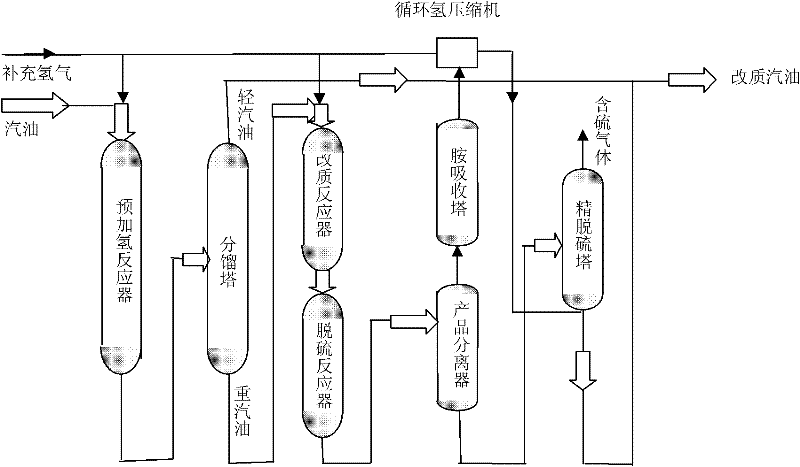Method for gasoline modification
A gasoline and upgrading technology, which is applied in the petroleum industry, hydrocarbon oil treatment, hydrotreating process, etc., can solve the problem of large octane number loss, achieve small octane number loss, reduce mercaptan content, and reduce octane The effect of value loss
- Summary
- Abstract
- Description
- Claims
- Application Information
AI Technical Summary
Problems solved by technology
Method used
Image
Examples
Embodiment 1
[0030] The raw material oil that embodiment 1 uses is identical with comparative example. Catalytic gasoline is pretreated under the conditions of hydrogen partial pressure of 2.2Mpa and temperature of 160°C, and then enters the fractionating tower to cut into two components of light and heavy gasoline, and the heavy gasoline fraction accounts for 65% of the raw material. Heavy gasoline is first mixed with hydrogen into the hydro-upgrading reactor, under the reaction conditions of hydrogen partial pressure of 2.0MPa and reaction temperature of 385°C for hydro-upgrading, and then into the hydrodesulfurization reactor under the conditions of hydrogen partial pressure of 1.8MPa, 252 ℃ for hydrodesulfurization. After desulfurization, the product enters the fine desulfurization tower. Under the conditions of hydrogen partial pressure of 1.8Mpa, feed temperature of 300°C, tower top temperature of 260°C, tower bottom temperature of 350°C, and hydrogen-oil volume ratio of 50, the sulf...
Embodiment 2
[0032] The raw material oil that embodiment 2 uses is identical with comparative example. Catalytic gasoline is pretreated under the conditions of hydrogen partial pressure of 2.2Mpa and temperature of 160°C, and then enters the fractionating tower to cut into two components of light and heavy gasoline, and the heavy gasoline fraction accounts for 65% of the raw material. Heavy gasoline is first mixed with hydrogen into the hydro-upgrading reactor, under the reaction conditions of hydrogen partial pressure ℃ for hydrodesulfurization. After desulfurization, the product enters the fine desulfurization tower. Under the conditions of hydrogen partial pressure of 1.8Mpa, feed temperature of 300°C, tower top temperature of 260°C, tower bottom temperature of 350°C, and hydrogen-oil volume ratio of 50, the sulfur content of gasoline is further reduced with the fractionation tower Light gasoline from the top of the tower is mixed to obtain a modified gasoline product. See Table 2 for...
PUM
 Login to View More
Login to View More Abstract
Description
Claims
Application Information
 Login to View More
Login to View More - R&D
- Intellectual Property
- Life Sciences
- Materials
- Tech Scout
- Unparalleled Data Quality
- Higher Quality Content
- 60% Fewer Hallucinations
Browse by: Latest US Patents, China's latest patents, Technical Efficacy Thesaurus, Application Domain, Technology Topic, Popular Technical Reports.
© 2025 PatSnap. All rights reserved.Legal|Privacy policy|Modern Slavery Act Transparency Statement|Sitemap|About US| Contact US: help@patsnap.com


